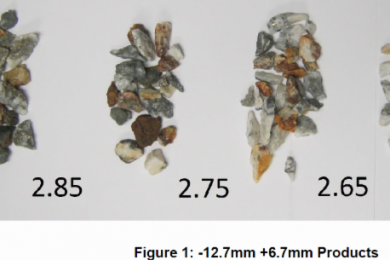Taranis Resources reports on exploration and mining activity related to its 100%-owned Thor project in southeast British Columbia, Canada. Pursuant to the successful permitting, execution and closure of the gold pilot plant at Thor, Taranis is moving forward with the permitting of a density media separation (DMS) plant at Thor (10 t/h). The endeavour will seek to permit and process several high-grade stockpiles at Thor that date from the early 1900s and 1970s.
Taranis undertook a detailed examination of the Thor stockpiles commencing in 2012 that included volume and grade calculations, environmental baseline monitoring and Acid Rock Drainage (ARD) characterization with full knowledge that stockpiles contained a valuable resource of metals. All work was done to NI 43-101 standards.
The stockpiles were mined from the main Thor deposit, and consequently the grade and metallurgy are representative of the main Thor Ag-Au-Pb-Zn-Cu deposit itself. The stockpiles are already broken and at surface, so no drilling and blasting is required.
The permitting application will be undertaken in two stages. The first will outline the concept and present it to the government permitting agencies, and develop a timeline. The second stage will incorporate the specifics of the operation including operation, design specifications, processing specifications and environmental monitoring to ensure the successful operation of the mine.
There are five very unique aspects of this second mining operation at Thor:
- It involves removing several ARD-producing stockpiles from the surface, some of which have been there for over 100 years
- The processing involves gravity concentration of the ore and will produce two products. The first of these is concentrate that will contain almost all the sulphide minerals and economic value, and this will be shipped offsite for further processing/smelting. The second will be spoils that will be essentially quartz and gangue minerals that have no economic value
- Taranis has received testing results from the gravity separation metallurgical tests that shows separation of most of the ARD-producing material into the concentrate that will be shipped offsite, and the spoils having minimal ARD producing characteristics
- The spoils are planned to be disposed of underground in a pre-existing tunnel that was developed in the 1930s and will have no surface exposure
- All stockpiles lie in areas where Taranis holds the Crown Grants.
Taranis worked with Norwest Corp on the closure of the gold pilot plant tailings site. Taranis says: “Norwest is an internationally-recognized leader in providing consulting expertise to the energy, mining, and natural resources industries, and has worked with Taranis to raise the bar for environmental practices at Thor, and Taranis looks forward to working with it on this permit application.
While Taranis is still processing the concentrates from the summer operation and recovering the gold, the plant was an enormous success and it allowed Taranis to get a much better understanding of the high-grade gold zones at Thor. It also led to the discovery of the continued extension of the deposit to the northwest and the SIF-Extension, which is an important exploration target in the future.
John Gardiner, President and CEO states “Taranis has adopted a staged approach to mining Thor that runs in tandem with continued exploration and expansion of the main in-situ deposit. Permitting is arguably the most difficult aspect of any mining operation in British Columbia, and the standards for permitting, mining and closure require detailed baseline environmental studies. We have been doing environmental work for upwards of five years at Thor in conjunction with our normal exploration activities, and this work has included ARD characterization, climate and water flow monitoring and baseline water and soil geochemistry. Taranis takes permitting very seriously.”
The picture shows DMS products at different SG cutoffs. Note the dark colour of the material on the left (concentrate) and the light color on the right (spoils). The dark colour is due to higher sulphide content, and this visually shows how effective DMS separation is at Thor.










